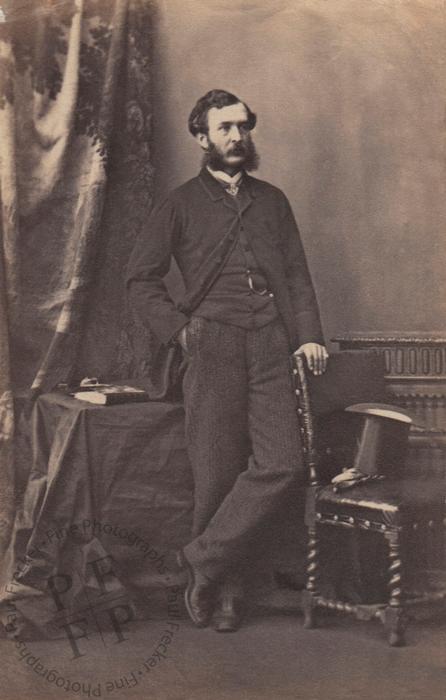J.W. Breeks, Esq.
(1830-1872)
19 December 1860
Volume 2, page 122, sitting number 1785.
Born at Warcop in Westmoreland on 5 May 1830, James Wilkinson Breeks was the son of Richard Breeks. He entered the Madras Civil Service in 1849.
On 19 February 1863 in the cathedral at Madras James Wilkinson Breeks married Susan Maria Denison, eldest daughter of Sir William Thomas Denison, KCB, Governor of Madras. Their marriage produced three sons and one daughter.
James Wilkinson Breeks ‘of Hillbeck Hall and Edengate, Westmoreland’ died at Ootacamund in the Presidency of Madras in India on 6 June 1872 (Shields Daily Gazette, 13 July 1872). He was 42 years old. He left an estate valued at £3000. His older brother Richard had died Trichinopoly, also in the Madras Presidency, on 19 February 1852 and his sister Margaret Sarah Thomson had died at Malligaum in the Bombay Presidency on 3 September 1864.
After his death his Account of the Primitive Tribes and Monuments in the Nílagiris was published.
According to his entry in the Dictionary of National Biography: ‘After filling various subordinate offices in the revenue and financial departments, he was appointed private secretary to Sir William Denison, governor of Madras, in 1861, holding that appointment until the latter part of 1864, when, owning to ill-health, he left India and joined a mercantile firm in London, with the intention of retiring from the public service; but this arrangement not proving satisfactory, he returned to Madras in the autumn of 1867, and was shortly afterwards appointed to the newly constituted office of commissioner of the Níligiris, the principal sanatorium in the south of India. [The district enjoys a cooler climate than the surrounding plains and was therefore a popular retreat for Europeans.] While thus employed, Breeks, in common with other heads of districts in the Madras presidency, was, in 1871, called upon by the government, at the instance of the trustees of the Indian Museum at Calcutta, to make a collection of arms, ornaments, dresses, household utensils, tools, agricultural implements, &c., which would serve to illustrate the habits and modes of life of the aboriginal tribes in the district, as well as a collection of objects found in ancient cairns and monuments.
‘The discharge of this duty, which he performed in a very thorough and satisfactory manner, cost him his life; for having occasion, towards the close of his investigation, to visit a feverish locality in a low part of the mountain range, he there laid the seeds of an illness which a few months later caused his death. In the meantime he had made a complete collection of utensils, arms, &c., in use among the four aboriginal tribes of the Níligiris, the Todas, Kotas, Kurumbas, and Irulas, and of the contents of many cairns and cromlechs, and had written the greater part of the rough draft of a report, which, completed and edited by his widow, who had been closely associated with him in his inquiries, was published in London by order of the secretary of state.
‘This report contains a very full account of each of the four tribes above mentioned, illustrated by drawings and photographs, and supplemented by a brief notice of some similar remains in other parts of India. Photographs of the men and women of the several tribes, of their villages, houses, temples, &c., are also given; as well as a vocabulary of the tribes, and descriptive catalogues of the ornaments, implements, &c., now in use. The book is a valuable record of intelligent and accurate research.
‘The Breeks Memorial School at Ootacamund, for the children of poor Europeans and Eurasians, was erected by public subscription shortly after his death as a memorial of his services to the Níligiris community.’

